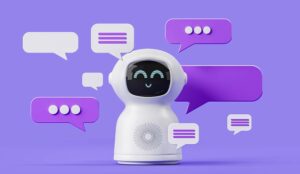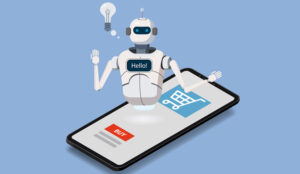Nicolas Marcoin at Odigo explores how the evolution of chatbots could finally overcome longstanding limitations, transforming customer service and digital engagement.
In 1907, L. Frank Baum introduced what is arguably the first talking human-like ‘robot’ in literature, though the term was only coined later. In his children’s novel Ozma of Oz, Tik-Tok’s clockwork mechanism powered both his thinking and movement.
Roughly a century later, chatbots made their way into customer service. Like Tik-Tok, who couldn’t wind himself, these early bots were far from perfect. Even today, they can still fall short of expectations. Now, in the era of generative AI, could chatbots finally overcome their limitations?
Chatbots: Promises, Challenges, and the Road Ahead
When they first entered the market, chatbots symbolised a new era of digital communication. Their interface closely resembled popular instant messaging apps like Messenger, widely used by younger generations. These familiar cues were designed intentionally to reassure users.
Consumers also became, and continue to be, more self-sufficient in the digital world. In 2010, Forrester reported that 72% of customers and prospects preferred to solve their issues independently rather than dealing with customer service.
This shift in behaviour suggested that chatbots had all the right ingredients to become the go-to digital channel for problem-solving.
However, traditional chatbots have significant shortcomings that have not gone unnoticed. They struggle to understand even the most common requests and often lack the expertise needed to provide relevant answers, often because they are not connected to a company’s knowledge base or operate in siloes isolated from the data of other departments within an organisation.
As a result, issues are often escalated to another channel, forcing customers to repeat their problem from the beginning.
According to ContactBabel’s 2024 UK Contact Centre Decision-Makers’ Guide, while only 36% of respondents preferred contacting a company by phone for complex issues, a significant 64.1% of inbound interactions still occur via live agent calls.
After a decade of efforts to revolutionise customer service, these numbers highlight the ongoing challenges.
Generative AI: A Chatbot Game-Changer?
So, if traditional chatbots lack precision and relevance, could this issue be resolved with generative AI? These AI models can generate answers and more natural responses to questions based on information in specific knowledge bases to which they are given access.
It follows that a chatbot powered by generative AI and informed by a company’s own data is better equipped to respond accurately to queries. Generative AI-enhanced chatbots with access to key company documents can give customers more up-to-date and precise answers.
Best Practice: Precautions and Safeguards
Generative AI is still relatively new. To ensure quality and compliance, it must be properly configured and regularly monitored.
The golden rule when setting up generative AI is to grant it access only to verified internal data. Relying on external sources risks disrupting the AI’s learning process, potentially leading to inaccurate responses or so-called “hallucinations”.
In a landmark case, Air Canada was held responsible for misinformation provided by its chatbot, despite claiming that the chatbot was a “separate legal entity that is responsible for its own actions”.
The customer was awarded damages, with tribunal member Christoper Rivers noting in the written response, “It should be obvious to Air Canada that it is responsible for all the information on its website.”
To mitigate similar issues, businesses should implement robust quality controls, including offering supplementary links as evidence. In the Air Canada case, although a link was provided, the customer did not follow it, trusting the chatbot’s (incorrect) answer.
It’s crucial to ensure bots are programmed to escalate issues they cannot accurately address and to prompt customers to double-check key information, such as terms and conditions.
Including disclaimers – reminding customers to verify eligibility or review the small print – could also help avoid misunderstandings, especially when specific details may not have been disclosed by the customer.
How AI-Powered Chatbots Enhance Digital Engagement
Despite mixed opinions of traditional chatbot, their potential shouldn’t be underestimated when enhanced with newer AI models and when deployed in specific use cases:
- Pre-processing for complex requests
- Engaging the customer for the first time on the web page
- Suggesting complementary products and services
Streamlining resolution and improving digital conversion rates are just two of the benefits. However, to fully realise the potential of chatbots, they must be integrated into a broader system.
Like a bird with clipped wings, a chatbot that’s disconnected from other channels and databases is unable to soar to its full potential, limiting its ability to deliver the seamless and intelligent interactions customers expect.
By integrating it with the rest of your system, you enable seamless and contextual escalation to agents who handle requests via instant messaging.
In cases of complex requests or those with significant business impact, such as contract cancellations, a bot within an omnichannel system can directly connect the customer to an agent by phone.
Additionally, an effective chatbot opens up many opportunities for process automation: loan application simulations, compensation calculations, purchase assistance, and more.
Choosing the Right Tool and Methodology
Selecting the appropriate chatbot is crucial. It must fit within a comprehensive suite of tools for managing digital interactions and follow the complete customer journey from the distribution engine to resolution.
To achieve greater flexibility and handle the same request across various communication channels in a consistent way the best solution is an omnichannel platform that allows smooth transitions between channels.
Conclusion
To maximise the benefits of next-generation chatbots, it’s essential to choose the right tool and integrate it thoughtfully into your broader digital ecosystem.
An effective chatbot should not only streamline interactions across various channels but also support intelligent escalation to human agents when needed.
That said, the power of generative AI comes with responsibilities. Ensuring accurate and compliant responses requires careful configuration and monitoring.
By using high-quality data and implementing safeguards – such as quality control checks and linking responses to official company documents – you can help prevent misinformation and build trust.
Author: Odigo
Reviewed by: Jo Robinson
Published On: 10th Oct 2024 - Last modified: 22nd Oct 2024
Read more about - Guest Blogs, Nicolas Marcoin, Odigo



































